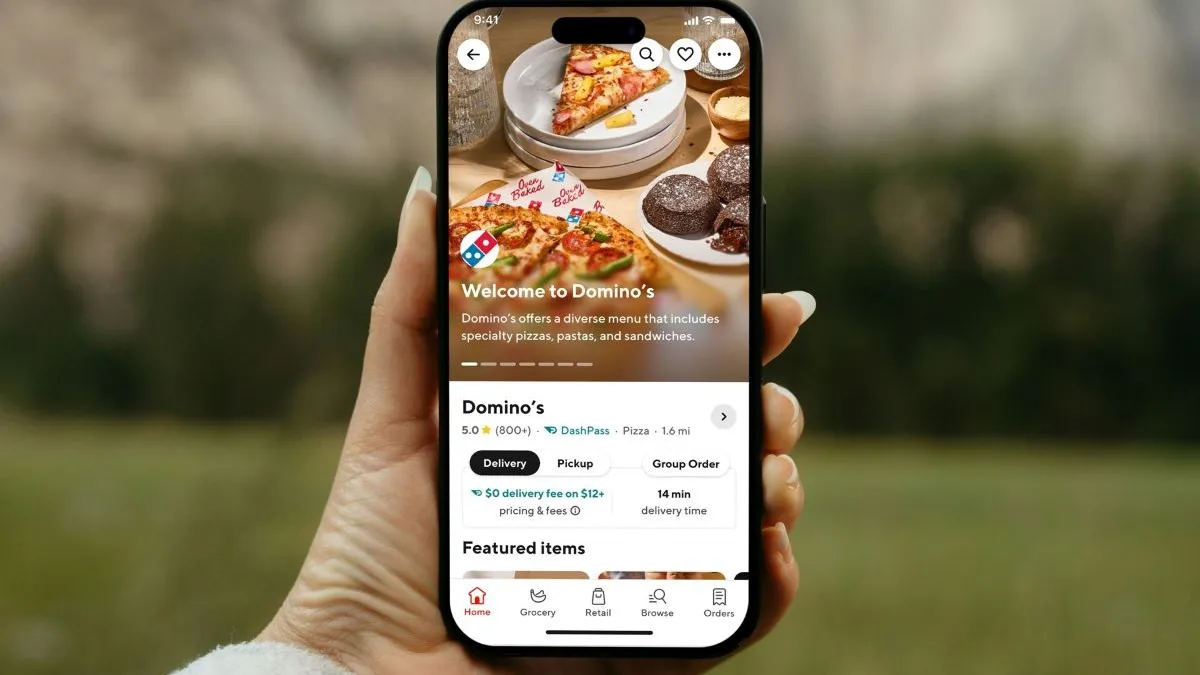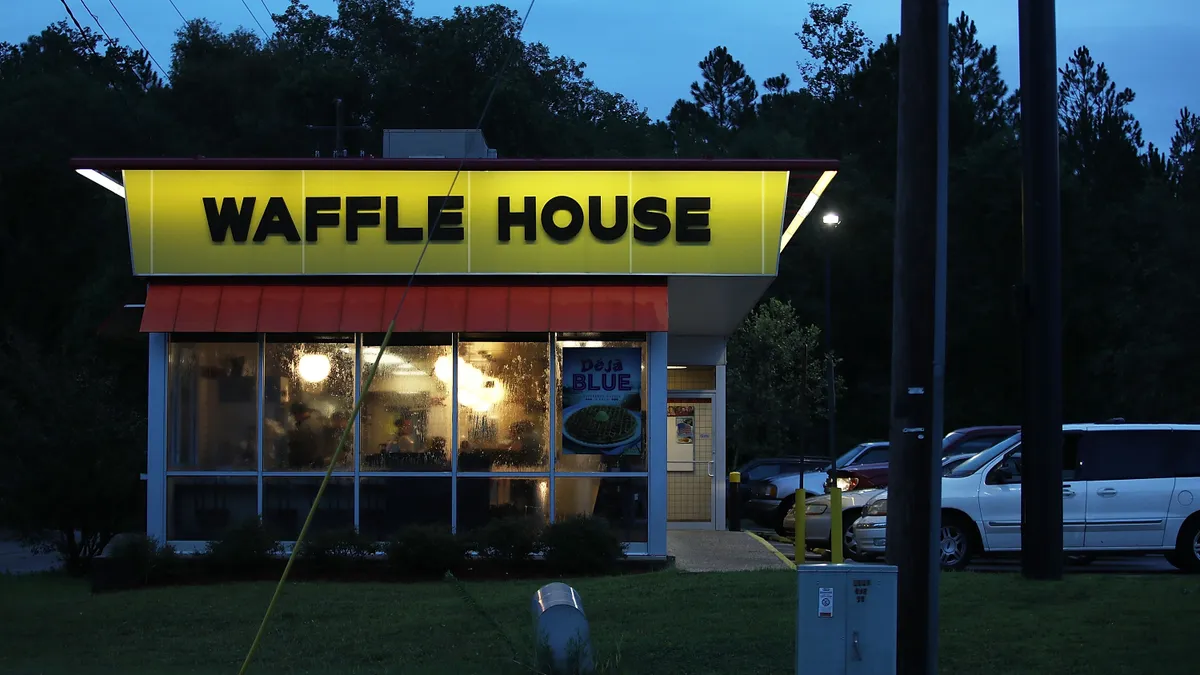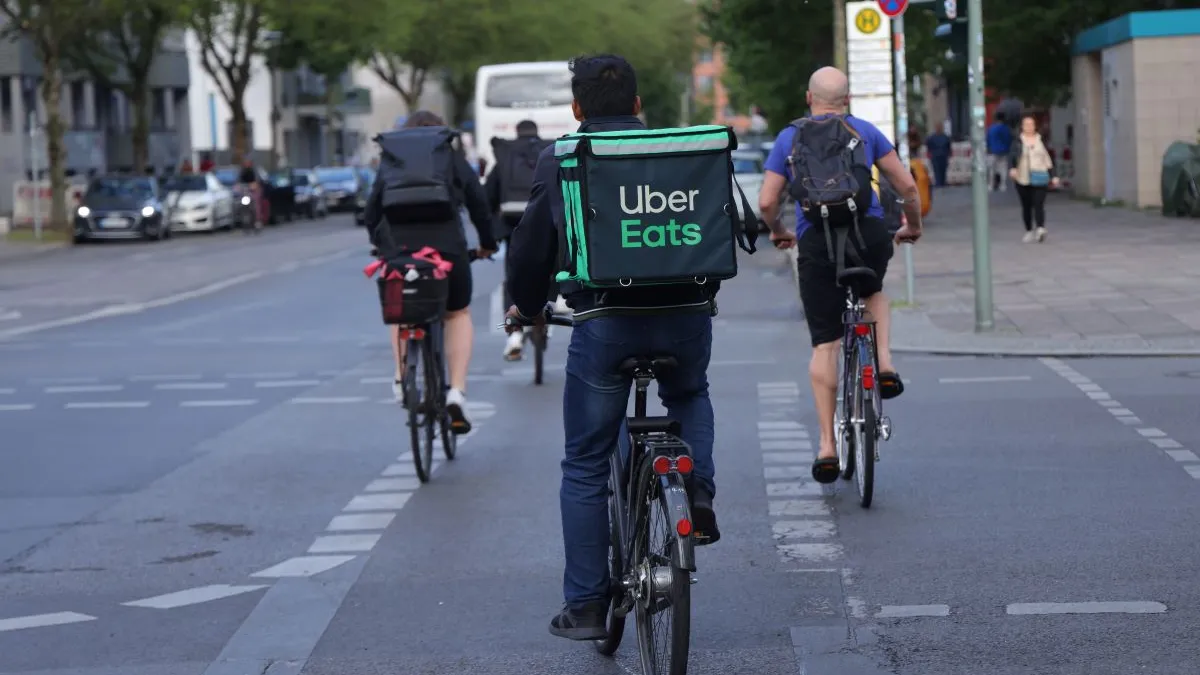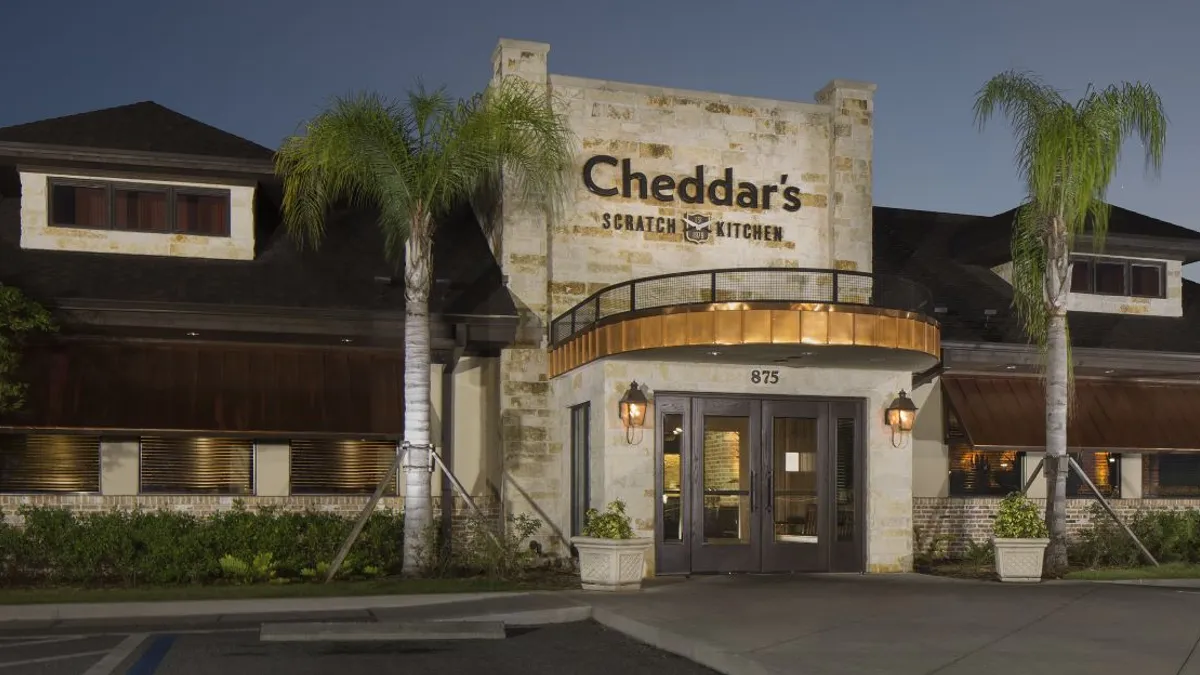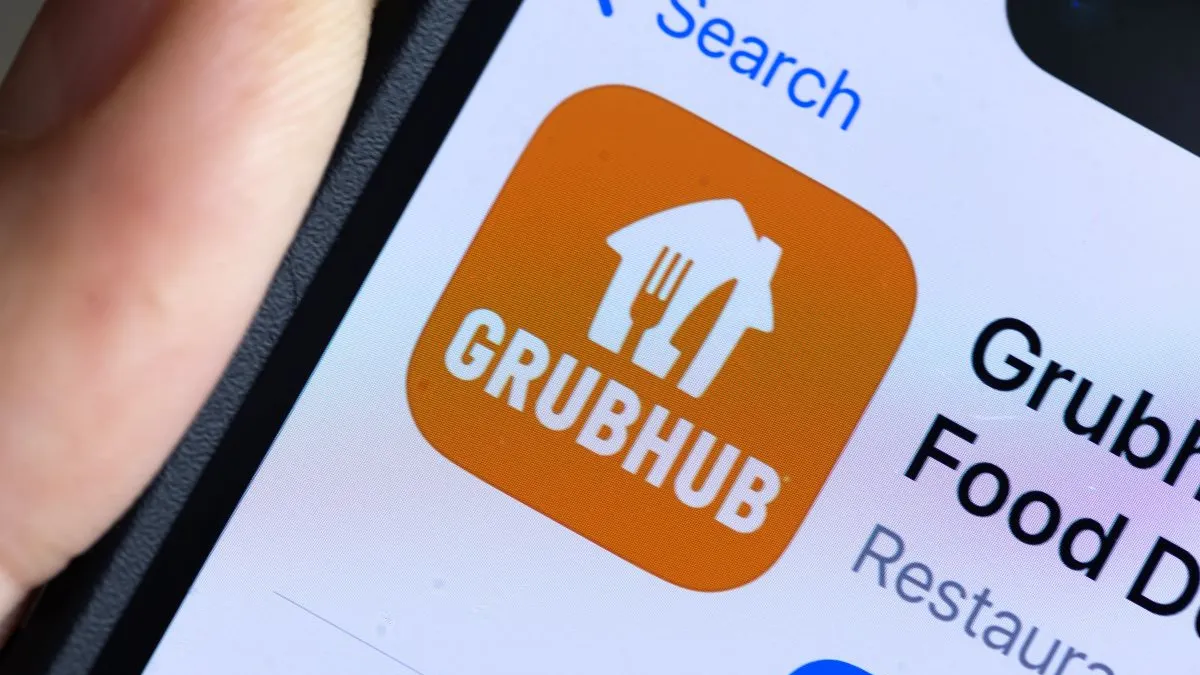This article is the second in a six-part series exploring the growth of the ghost kitchen market. Next week, Restaurant Dive will look at the major brands that have invested in ghost kitchen concepts this year. The full series will be posted here.
When Dog Haus expanded into delivery with the launch of its app in 2018, something didn't add up. The majority of the restaurant's off-premise orders were for hot dogs, when the menu item only made up 25% of in-house sales, co-founder André Vener said. The company's sausages, burgers, chicken and plant-based items were largely going unnoticed on delivery apps.
The problem? Third-party platforms only allow restaurants to choose three searchable terms to represent their business. Dog Haus had selected search terms like "Americana," "hot dogs" and "burgers." So when a diners searched for "chicken" on a delivery app, for example, Dog Haus wouldn't appear, Vener said.
To solve this problem and bolster digital sales, Vener and co-founders Hagop Giragossian and Quasim Riaz began the process of creating virtual brands about 18 months ago, developing concepts representing its existing menu offerings. Bad Mutha Clucka offers Dog Haus' chicken sandwiches, Freiburger highlights the restaurant's burgers and Plant B sells its plant-based foods. The company also created Bad Ass Breakfast Burritos to create a breakfast option. Each menu includes a few LTOs that Dog Haus has offered in the past, bulking up the offerings while also avoiding the need to buy new ingredients, Vener said. The online-only brands would be housed under Dog Haus' virtual banner company, The Absolute Brands.
The initial strategy was to launch the brands in 2021 in ghost kitchens like Kitchen United and Cloud Kitchens, which the restaurant had already partnered with for its Dog Haus brand. But when the pandemic hit and dining rooms were closed, the company accelerated its plans, rolling out The Absolute Brands in March and allowing franchisees to use their kitchen space to develop these brands alongside existing third-party ghost kitchen operations, Vener said. Because the brands use menu items and ingredients operators already have stocked, the Dog Haus team was able to roll out the concepts very quickly.
"[Franchisees] all took a gamble on it, and we took a gamble," Vener said, "And it changed everything with our relationship with the franchisees. They couldn't be happier right now."
The risk paid off. One operator in Chicago was barely making $10,000 a week during the height of the pandemic lockdowns, but is now the third-busiest restaurant in its system and is raking in $50,000 a week after adding the virtual brands, Vener said. Systemwide, same-store sales were up 110% May, June and July compared to that same time frame in 2019.
By the end of next year, Vener predicts the industry will better understand how ghost kitchens can be profitable for third-party delivery, shared kitchen platforms and participating restaurants.
"We're all just kind of still at the beginning phases of the ghost kitchen," Vener said. "We could get along perfectly — the venue, … the concept and third-party delivery person — but we need to make sure that it works for the customer, otherwise we don't have a business."
Striking that balance isn't easy. A lot of time went into examining menu pricing and the cost of labor, operating hours, marketing and packaging to ensure profitability, Vener said. And despite their promise of lower overhead costs and delivery sales opportunity, experts say that virtual brands aren't always successful. To ensure long-term success, operators need airtight business plans that consider all of these elements, as well as additional costs from packaging, digital and built-in third-party commissions.
Develop the right menu pricing strategy
For The Absolute Brands, determining pricing took trial and error. Menu prices need to reflect the cost of third-party delivery commissions and other operating costs, like paper and packaging, which increase with a delivery operation, Vener said. Packaging is an important marketing tool, but operators shouldn't spend a lot on this until they know consumers are responding well to the brand, Vener said. Initial packaging can be as simple as a stamp with the brand name on a container, but once a brand gains traction the parent company should develop more sophisticated materials that can improve food quality during travel, he added.
Customers that want food delivered versus picking it up themselves should be charged for the extra costs associated with that service, he said.
"I just see so many people [with] these virtual kitchens … moving in and people moving out [of shared kitchens] all the time, and I guarantee it's because of food costs," Vener said.
Dog Haus analyzed data from various systems to understand demand and ensure pricing would attract sales and still cover expenses, Vener said. He added that operators need to judge pricing based on their own data points and avoid price gouging based on competitor menus because there is no way to know if that competitor is selling one burger a day or 100, for example.
Restaurants don't have to develop pricing alone, either. Restaurant supplier US Foods, for instance, offers insights into pricing and profitability through its Menu Profit Pro tool, which can provide tips on simple and complex menu items, Adam Stinn, director of business solutions at US Foods, said. The company also provides strategy suggestions based on current food purchases and what could be the easiest item to set up as part of the off-premise-only kitchen, Stinn said. For example, one of its clients in St. Louis used US Foods' ghost kitchen platform to identify what was around them, how to create a successful brand and what profitability mechanisms look like, which led to the creation of a wing concept, Stinn said.
US Foods has a lot of interest from clients considering both on-premise and off-premise virtual kitchens because of the impact the winter months will have on patio dining, Stinn said.
"This could be a really viable option for them," Stinn said. "Seventy-five percent of operators consider off-premise dining their best growth opportunity. I don't see it going away."
It's also important for restaurants to ensure virtual concept offerings don't undercut the sales of their main company, experts said.
"You don't need to create something entirely new and different, but rather complementary to your existing operation," Joy Lai, chief operating officer at Kitchen United, said.
Formulate a marketing plan
As The Absolute Brands launched its virtual concepts, Vener said his team quickly found out how important marketing was. He and his colleagues originally thought partnering with the four biggest delivery platforms would be enough to attract diners, but that wasn't the case.
"I thought everything could be done through third-party delivery, but you need to continue [to use traditional digital marketing]," Vener said. "It was just more money we had to put into that. We didn't think we had to double down on that."
In addition to its listing on third-party apps, The Absolute Brands created websites for Bad Ass Breakfast Burritos, Bad Mutha Clucka, Freiburger and Plant B and boosted each brand's digital marketing.
"Consumers don't know what you're doing until you tell them," John Kelly, CEO of marketing software maker Zenreach, said.
Online engagement is at an all-time high right now and the cost of online advertising has declined, making it the perfect time to market online, Kelly said.
"While the off-premise market is booming, especially during this time, no brand can simply start up delivery and takeout and expect it to be a huge and immediate success," Lai said, adding that operators need a planned strategy that will allow it to draw in and engage customers while also executing off-premise smoothly.
Restaurants that are established in their markets, have a dedicated following and digital connections to their consumers tend to be the most successful with Kitchen United's model, Lai added.
Chick-fil-A is among the well-known brands that have been partnering with ghost kitchen providers, including Kitchen United. Because of its trustworthy reputation, customers aren't likely to mind if the chain’s food isn't coming from a traditional restaurant, Chris Shaker, CPA and consumer products partner at restaurant consulting firm RSM, said.
For restaurants that don't have a well-known brand, there is a risk if something doesn't go well, Shaker said. If it doesn't taste the same as a restaurant experience or arrives late, there could be lasting consequences, Shaker said.
"Not only did you not drive those new sales you were looking for through this channel, but you've actually damaged the brand and perhaps cost yourself some sales on site," Shaker said.
US Foods, which created a ghost kitchen service platform in August, also helps guide clients on setting up websites, improving search engine optimization, leveraging social media platforms and improving their Google profile because Google is the top discovery mechanism online, Stinn said.
ShiftPixy, a tech platform that offers on-demand staffing for the gig economy workforce and also offers a platform for native delivery, is helping brands extend themselves digitally, create new cuisines or expand customer reach, CEO Scott Absher said.
"[Some small brands] need a lot more help because if they're going to survive and thrive in that type of environment, they must have digital assets," Absher said. "They must have the ability to be a good digital marketer."
Restaurants need to spend more time on technological engagement and processes than they do on kitchen management and processes, Absher said.
"A lot of people say, 'Well I have a website.' … That's not good enough. If they paid attention to the consumer habit, if you're going to detach from physical real estate, … the people you're running after are app savvy,"Absher said.
Don't forget labor and operating costs
The most successful virtual brands also understand their food, labor and operating costs to ensure that a ghost kitchen operation is profitable. Kitchen United charges a monthly fee that covers a fixed portion of rents and services and takes a percentage for orders that originate from its website and digital channels, Lai said, adding that the cost of running an operation inside a Kitchen United is a fraction of the costs of opening a traditional brick-and-mortar location. The fees charged vary depending on a restaurant's requested capacity, overlay services such as marketing support, business intelligence, equipment maintenance and cleaning, as well as shared back- and front-of-house labor, Lai said.
Typical rent at a shared kitchen in a major metro area like New York, San Francisco and Los Angeles costs about $100,000 per year plus about $50,000 for two to three cooks, resulting in $250,000 in fixed costs, said Dan Fleischmann, vice president at Kitchen Fund. Kitchen Fund is a growth investor specializing in emerging restaurants. Fleischmann interviewed restaurant operators and ghost kitchen providers to create a ghost kitchen spreadsheet that brands can use to determine if they would run at a profit or a loss.
While this is much cheaper than starting up a brick-and-mortar restaurant, which can cost into the millions, all of the sales coming out of these locations are delivery only, which made up roughly 7% of the industry before the pandemic, he said.
With additional costs associated with delivery, including commissions, food and other expenses, Fleischmann said operators have to make at least $650,000 in ghost kitchen sales to break even, which he said is difficult to do as a delivery-only operation. For example, before the pandemic, Chipotle had an average unit volume of $2.2 million with digital sales at about 20%. That means delivery sales would make up about $400,000, which wouldn't be enough to make a ghost kitchen cost structure profitable, Fleischmann said.
Labor is also a key cost. Most of Kitchen United's restaurant partners operate with two of their staff members preparing the food while Kitchen United's staff handles cleaning, order handoff and other tasks, Lai said.
Managing hours is important, too. Kitchens could be busy for two hours for breakfast, lunch and dinner, but that doesn't make sense to have someone work for two-hour shifts at a time, Vener said. Staff need to be involved in other tasks, like marketing, finance, prep, inventory and other tasks, he said.
"Make sure that you're maximizing your staff and cross-training them," Vener said.
Hours also could be different at a ghost kitchen operation versus a physical restaurant, Vener said.
Dog Haus used to close by 10 p.m., but one of its franchisee operators started to stay open later, and now 50% of that location's business comes between the hours of 9 p.m. and 2 a.m., Vener said.
Operators should also decide if they want to have someone on staff who will deliver food and double as a brand ambassador or have third-party delivery couriers deliver for multiple restaurants, Absher said.
"You're still going to have to leverage human capital to complete the cycle," Absher said. "If they don't run the delivery correctly, this operation, this idea, this whole notion of how that ghost kitchen should help, it's going to fall apart."
Having in-house delivery allows restaurants to better manage customer engagement, lower overhead costs and control menu pricing, he said.
"If you're unshackling from physical real estate, you're reducing your overhead substantially to add a couple more people in there to help with deliveries," Absher said. "The economics are in your favor, plus you control your menu pricing."
And before jumping into a ghost kitchen space, restaurants should consider the shifting labor and real estate landscapes. With as many as 100,000 restaurants closing for good so far this year, there are second-generation restaurant spaces available that operators could get at a substantially cheaper rate, Fleischmann said.
At the same time, creating a virtual brand within a restaurant's existing space and cost base can be more affordable than opening in a shared kitchen, he said. Brinker International went this route launching It's Just Wings during the last week of fiscal 2020 across 1,000 of its restaurants and is on its way to being a $150 million business, Fleischmann said.
If an operator decides to go down the virtual brand route, there can be a hefty reward at the end, as The Absolute Brands has found.
"Right now there's more people leaving virtual kitchens spaces than have stayed," Vener said. "However, if you figure it out, I think it’s a good option."
Within six months, The Absolute Brands' virtual concepts make up 25% of the company's business, with about 70% of its restaurant dining rooms shut down as of September.
"Our goal and our dream is to get back to 100% of sales with just Dog Haus and just have this other 25% be the gravy," Vener said. "But do I see it only going to delivery? No. I can't imagine a bar not being crowded at some point in the next 12 to 24 months."
The Ghost Kitchens series is brought to you by Leer, a recognized leader in the temperature-controlled storage industry. To learn more visit their website. Leer has no influence over Restaurant Dive's coverage within the articles, and content does not reflect the views or opinions of Leer and its employees.









